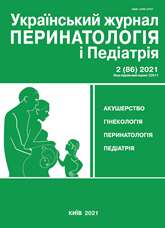Differential diagnosis of thrombocytopenia during pregnancy: clinical and diagnostic algorithms
DOI:
https://doi.org/10.15574/PP.2021.86.28Keywords:
thrombocytopenia, pregnancy, diagnostic algorithm, treatment algorithmAbstract
Purpose — to create an algorithm for early diagnosis and differential diagnosis of conditions accompanied by thrombocytopenia (TP) during pregnancy, as well as an algorithm for the treatment of immune thrombocytopenia during pregnancy based on analysis of clinical, laboratory data and obstetric and perinatal results of such pregnant women.
Materials and methods. We analyzed 155 histories of pregnancy and childbirth of women with TP, who underwent inpatient treatment and/or gave childbirth in the obstetric clinic of the State Institution «Institute of Pediatrics, Obstetrics and Gynecology named after Academician O.M. Lukyanova NAMS of Ukraine» from January 2008 to August 2018. According to the inclusion criteria, 111 histories were selected for further analysis. Pregnant women are divided according to the etiological principle of TP into three groups: with gestational thrombocytopenia, immune thrombocytopenia, secondary thrombocytopenia. The first group included 32 women (28.8%), the second — 65 (55.6%), the third — 14 (12.6%). During the selected period of time there were 99 births, 100 babies were born, 1 twin birth.
Results and conclusions. The number of platelets progressively decreases during pregnancy with a minimum in childbirth. The algorithm of examination, the decision on the initiation or intensification of treatment, the choice of monitoring tactics for TP during pregnancy, the calculation of obstetric and perinatal risks, preparation for childbirth and the choice of method depend on the cause of TP and differ significantly. Developed «Algorithm for diagnosis and differential diagnosis in the detection of thrombocytopenia during pregnancy» and «Algorithm for the treatment of immune thrombocytopenia during pregnancy» are aimed at the prevention of obstetric and perinatal complications in pregnant women with thrombocytopenia.
The research was carried out in accordance with the principles of the Helsinki declaration. The study protocol was approved by the Local Ethics Committee of an participating institution. The informed consent of the patient was obtained for conducting the studies.
No conflict of interest was declared by the authors.
References
ACOG. (2019). Practice Bulletin No. 207: Thrombocytopenia in Pregnancy. Obstet Gynecol. 133: 181. https://doi.org/10.1097/AOG.0000000000003100
Davyidova YuV, Limanskaya AYu, Ogorodnik AO, Butenko LP, Bayder AK. (2017). Sovremennyie podhodyi k korrektsii trombotsitopenii vo vremya gestatsii i v poslerodovom periode. Zdorovia Ukrainy 21 storichchia. 11-12: 408-409.
George JN, McIntosh JJ. (2020, Apr). Thrombocytopenia in pregnancy. UpToDate.
Gernsheimer T, James AH, Stasi R. (2013). How I treat thrombocytopenia in pregnancy. Blood. 121 (1): 38-47. https://doi.org/10.1182/blood-2012-08-448944; PMid:23149846
Jamal S, Goel N, Mehta A, Ahuja M. (2017). Recurrent severe gestational thrombocytopenia in pregnancy: a case report. Int J Adv Med. 4: 1702-1705. https://doi.org/10.18203/2349-3933.ijam20175196
Kim BJ, Kim HS, Kim JH, Lee KY. (2017). Moderate to Severe Thrombocytopenia During Pregnancy: A Single Institutional Experience. Indian J Hematol Blood Transfus. 33 (4): 581-585. https://doi.org/10.1007/s12288-017-0784-1; PMid:29075073 PMCid:PMC5640537
Loustau V, Debouverie O, Canoui-Poitrine F, Baili L, Khellaf M et al. (2014). Effect of pregnancy on the course of immune thrombocytopenia: a retrospective study of 118 pregnancies in 82 women. Br J Haematol. 166 (6): 929-935. https://doi.org/10.1111/bjh.12976; PMid:24957165
Palta A, Dhiman P. (2016). Thrombocytopenia in pregnancy. J Obstet Gynaecol. 36 (2): 146-152. https://doi.org/10.3109/01443615.2015.1041893; PMid:26431056
Parnas M, Sheiner E, Shoham-Vardi I, Burstein E, Yermiahu T, Levi I, Holcberg G, Yerushalmi R. (2006). Moderate to severe thrombocytopenia during pregnancy. Eur J Obstet Gynecol Reprod Biol. 128 (1-2): 163-168. https://doi.org/10.1016/j.ejogrb.2005.12.031; PMid:16533554
Pavord S, Hunt B. (2010). The Obstetric Hematology Manual. Cambridge University Press. https://doi.org/10.1017/CBO9780511676451
Provan D, Arnold DM, Bussel JB, Chong BH, Cooper N et al. (2019). Updated international consensus report on the investigation and management of primary immune thrombocytopenia. Blood. 3 (22): 3780-3817. https://doi.org/10.1182/bloodadvances.2019000812; PMid:31770441 PMCid:PMC6880896
Rajasekhar A, Gernsheimer T, Stasi R, James AH. (2013). 2013 Clinical Practice Guide on Thrombocytopenia in Pregnancy. Washington, DC: American Society of Hematology.
Ramadan MK, Hubeich M, Itani SE, Mogharbil A. (2016). Severe Gestational Thrombocytopenia: A Case Report and Brief Review of the Literature. Journal of Hematology. 5 (4): 142-150. https://doi.org/10.14740/jh308w
Reese JA, Peck JD, Deschamps DR, McIntosh JJ, Knudtson EJ et al. (2018). Platelet Counts during Pregnancy. N Engl J Med. 379: 32-43. https://doi.org/10.1056/NEJMoa1802897; PMid:29972751 PMCid:PMC6049077
Reese JA, Peck JD, Yu Z, Scordino TA, Deschamps DR et al. (2019). Platelet sequestration and consumption in the placental intervillous space contribute to lower platelet counts during pregnancy. Am J Hematol. 94 (1): 8-11. https://doi.org/10.1002/ajh.25321; PMid:30328633 PMCid:PMC6447301
Rodeghiero F, Stasi R, Gernsheimer T, Michel M, Provan D et al. (2009, Mar 12). Standardization of terminology, definitions and outcome criteria in immune thrombocytopenic purpura of adults and children: report from an international working group. Blood. 113 (11): 2386-2393. https://doi.org/10.1182/blood-2008-07-162503; PMid:19005182
Sankaran S, Robinson SE. (2011). Immune thrombocytopenia and pregnancy. Obstet Med. 4 (4): 140-146. https://doi.org/10.1258/om.2011.110025; PMid:27579112 PMCid:PMC4989643
Webert KE, Mittal R, Sigouin C, Heddle NM, Kelton JG. (2003). A retrospective 11-year analysis of obstetric patients with idiopathic thrombocytopenic purpura. Blood. 102: 4306-4311. https://doi.org/10.1182/blood-2002-10-3317; PMid:12947011
Downloads
Published
Issue
Section
License
The policy of the Journal “Ukrainian Journal of Perinatology and Pediatrics” is compatible with the vast majority of funders' of open access and self-archiving policies. The journal provides immediate open access route being convinced that everyone – not only scientists - can benefit from research results, and publishes articles exclusively under open access distribution, with a Creative Commons Attribution-Noncommercial 4.0 international license(СС BY-NC).
Authors transfer the copyright to the Journal “MODERN PEDIATRICS. UKRAINE” when the manuscript is accepted for publication. Authors declare that this manuscript has not been published nor is under simultaneous consideration for publication elsewhere. After publication, the articles become freely available on-line to the public.
Readers have the right to use, distribute, and reproduce articles in any medium, provided the articles and the journal are properly cited.
The use of published materials for commercial purposes is strongly prohibited.

